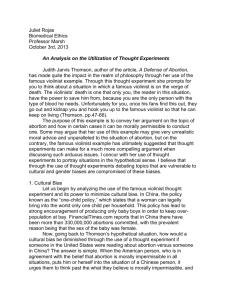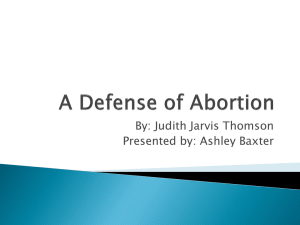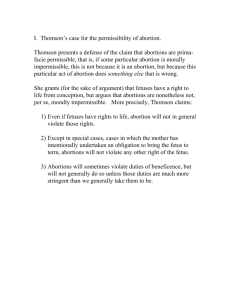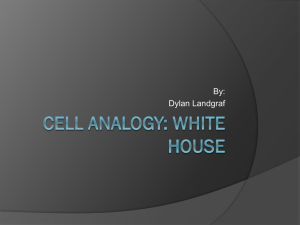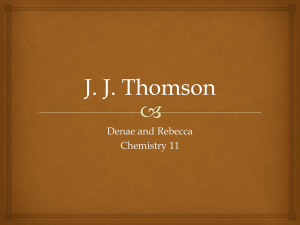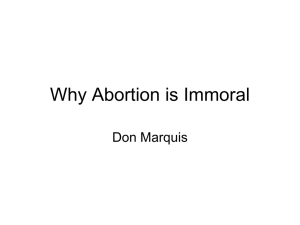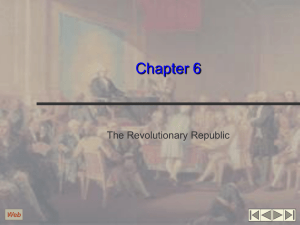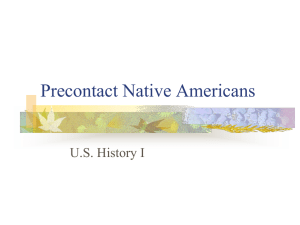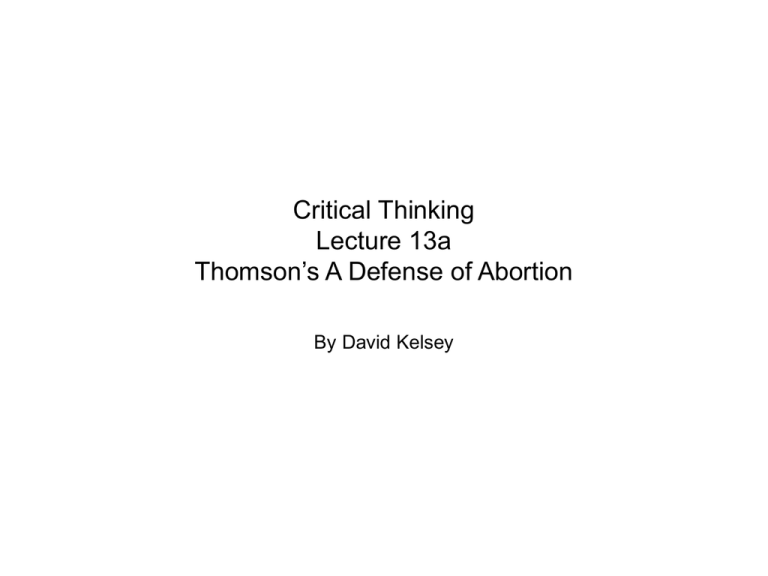
Critical Thinking
Lecture 13a
Thomson’s A Defense of Abortion
By David Kelsey
The most common argument
for the impermissibility of abortion
• The main argument strategy for the impermissibility of abortion:
–
–
–
–
–
1-A fetus is a person
2-Every person has a right to life
3-A fetus has a right to life (from 1 & 2)
4-A woman has a right to decide what happens in and to her body
5-The fetus’ right to life trumps the mother’s right to decide what happens in
and to her body.
– 6-Abortion is impermissible.
– Where would you challenge this argument?
Thomson rejects premise 5
•
In response to the argument from the previous slide:
–
Most folks try to argue that premise 1 is false.
• They try to argue that ______________________.
– Thomson tries a different tact:
• Which premise does she go after?
• Thomson argues that the scope of the right to life of the fetus doesn’t include the
right to the use of the expectant mother’s body
• Thus, the mother’s right to control what happens in & to her body cannot be
trumped by ____________________.
• What kind of argument does Thomson make?
The Violinist Analogy
•
The Violinist analogy is supposed to be analogous to a case in which a
woman becomes pregnant as a result of rape.
•
The terms of the analogy:
– The violinist is analogous to ___________.
– The kidnap victim is analogous to ___________.
– Unplugging from the violinist is analogous to ______________.
•
Question: Would you unplug from the Violinist?
– If so you must also accept what?
The Tiny House
•
This case is analogous to one in which pregnancy will result in the
death of the mother.
•
Terms of the analogy:
– The rapidly growing child is analogous to __________.
– The mother trapped in the house is analogous to _____________.
– Killing the rapidly growing child is analogous to ___________.
•
If your intuition is that the mother has the right to defend her life against
the rapidly growing child, you must admit what?
People Seeds
•
The People seeds case is supposed to be analogous to a case in which a
pregnancy resulted although some form of protection was used.
•
Terms of the analogy:
–
–
–
•
The people seeds are analogous to _________.
The house is supposed to be analogous to ___________.
The fine mesh screen is analogous to _____________.
Thomson thinks the person plant that finds it’s way through the screen and
develops doesn’t have a right to the use of your house.
–
So according to Thomson, a fetus that results from the use of protection has no right to
the use of what?
Minimally decent Samaritans
•
For Thomson, it’s not that she thinks that any old reason for having an
abortion will justify getting the abortion.
•
If it is a mere inconvenience for the woman to get the abortion, then it
would be indecent of her to do so.
– Question: what if pregnancy lasted only an hour?
– So Thomson thinks the mother must be at least a __________________.
– The case of Kitty Genovese!
Objections to Thomson:
The Weirdness objection
•
Thomson’s Violinist case and the others are too dissimilar to the
different cases of abortion because Thomson’s cases are all too weird.
•
The reply:
– Questionable relevance
The Tacit Consent Objection
•
What does Thomson say about consensual sex?
– What if the expecting parents wanted to have a child all along and then
something came up? What if they changed their minds?
•
Thomson’s response:
– If it isn’t too much of an inconvenience on the mother to have the child then
she ought to.
– If it is too much of a burden on the mother then abortion is permissible
because, after all, consent can be withdrawn.
The Responsibility objection
•
You have a responsibility to care for the fetus in all cases except rape whereas
in Thomson’s analogies, for example the people seeds analogy, you have no
such responsibility.
•
Reply: But does this added responsibility widen the scope of the fetus’ right to
life?
The Killing vs. Letting Die
objection
•
Killing and letting die:
–
–
–
•
The Violinist case is a case of letting the violinist die.
Abortion is killing.
Question: Is killing worse than letting die?
Response:
–
The killing and letting die distinction does no work because Thomson is worried only
about what?
The Stranger vs. Offspring
Objection
•
The objection:
–
–
–
•
The violinist is a stranger
The mother child relationship is special though.
It is this relationship which obligates the mother to bring the child to term.
Response:
–
What’s the relevance of this objection?

